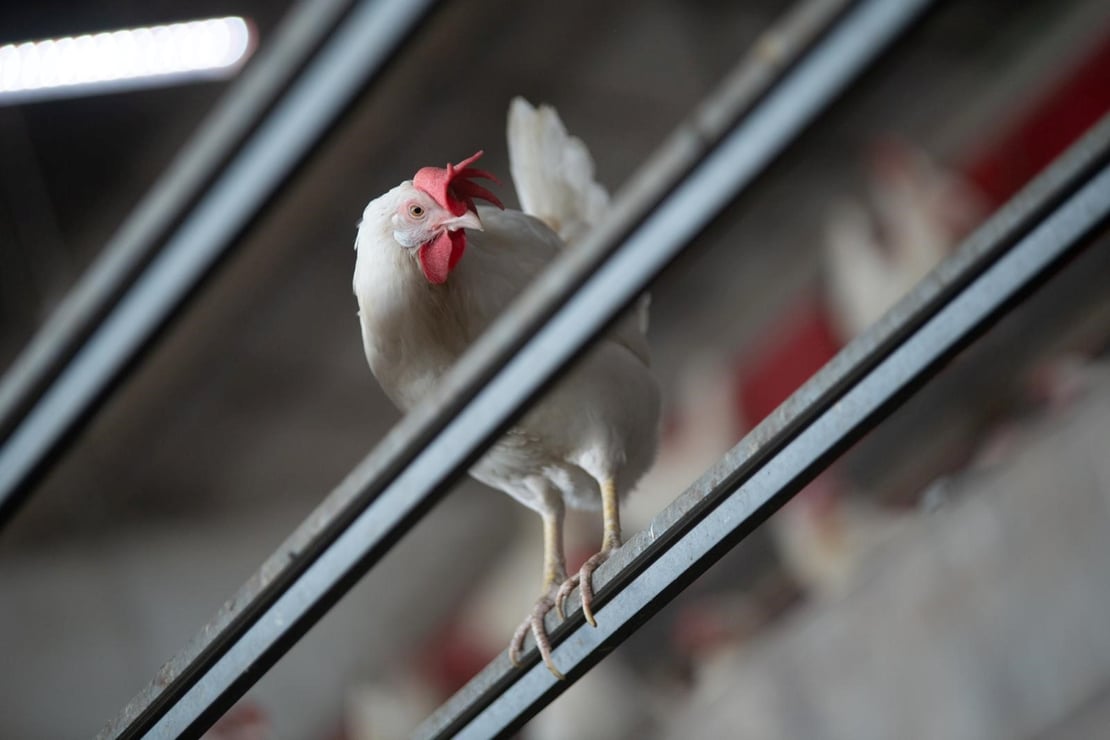The Netherlands - José van Gog of Devo Ei in Deurne knows all too well that red mite can have a major impact on operations. During the time her chickens were in a caged house, she tried everything to control the red mites: from green soap with spirit or eucalyptus to silica. Nothing had the desired effect, and the remedies that worked were banned. However, the switch to organic poultry farming in 2018 and the new house built for it brought a sustainable solution: the Q-Perch, which is fitted with a live wire that eliminates red mite. During this period, the fipronil affair was in play. José did not want to take any risks with her farm and therefore opted for these perches. As a result, the poultry farmer no longer has to use chemical pesticides and therefore 'no longer has to work in the chemical mess' herself. But how exactly do these perches work? And what about fire safety? Bas Liebregts, Product Manager at Vencomatic Group, explains more..jpg?width=600&height=400&name=Q-Perch%20Vencomatic%20Group%20(2).jpg)
How a perch kills red mite
In 2013, product developers at Vencomatic Group were tasked with tackling the problem of red mite in the industry. Their starting point was, as always, the natural lifestyle of the animal, in this case the red mite. The red mite, which feeds on the blood of chickens, follows a specific reproductive procedure. The developers wanted to break this cycle, preferably without chemicals.
Bas Liebregts explains how the red mite works: "At night, the mite approaches the chickens at their resting place. To reproduce, the mite must first drink blood from the chicken several times. This gives us an opportunity to stop the mite on their way to the chicken and thus interrupt the reproduction process."
By hindering reproduction, the population of red mite cannot grow further in the house. Unfortunately, mites can enter a house in various ways, such as through materials being brought in and out and through birds or pests. So there are numerous ways mites can enter a house. Poultry farmers therefore need a structural solution that can be continuously deployed to control.
"Fewer and fewer resources are allowed in the house. What will still be allowed in ten years' time?"
André Smid
Layer Farm
Eiboerderij Smid
Compare in practice: 3 houses with and 2 houses without Q-Perch
A practical example of the effectiveness of Q-Perch is provided by André Smid, who runs the laying hen farm Eiboerderij Smid in Heemserveen in Holland together with his parents Hergen and Jenneke and twin brother Dirk. On the farm, 120,000 laying hens scratch in and around the five houses, three of which have been equipped with Q-Perch for the past four years. André says: "When the house equipment needed replacing, we looked into different systems, with a view to the future. Fewer and fewer resources are allowed in the house. What will still be allowed in ten years' time?" The two houses with traditional perches are treated with Exzolt when red mite pressure is high. While this is effective, it also comes at a cost. There are no such recurring costs at the houses equipped with Q-Perch. André continues: "In these houses, we have not encountered any red mite since the installation of the Q-Perch. We no longer treat against anything, even when empty. We used to spray silica powder during vacancy, which is no longer necessary.".jpg?width=600&height=400&name=Q-Perch%20Vencomatic%20Group%20(3).jpg)
Cost savings and less aggression in the barn
André contrasts the savings on Exzolt with the investment costs of the Q-Perch. Although the purchase price of these perches is higher than that of traditional perches, the Smid family has no doubts about their choice: in the future, the two remaining houses will also be equipped with perches fitted with electric wire. "The beauty of this is that the chickens don't notice anything. The chickens don't come near the electric wire," André says. "With Q-Perch you don't add anything to the hens and because there are no mites, the birds are more comfortable."
"It is nicer for the chicken to perch on these sticks than on the wooden sticks or round tubes"
José van Gog
Layer farm
Devo Ei
José's chickens' moods have also improved significantly after the arrival of the new perches. "Because our chickens don't suffer from the red mite, they now eat less feed and are in better spirits. They are also less aggressive towards each other. There is much less pecking in the house." This is in contrast to the old house, where red mite problems worsened, leading to anaemia, a weakened immune system and ultimately the death of chickens. Because creating extra blood took energy, the chickens needed more feed. Bas adds that in certain situations, such as towards the end of the round, additional treatments alongside Q-Perch can be a good addition, to get the next round off to a good start as well. "This ensures that the poultry farmer can start again fresh and clean," he explains.
.jpg?width=600&height=400&name=Q-Perch%20Vencomatic%20Group%20(5).jpg)
Power in the house - what about fire safety?
Back to the design and functionality of the Q-Perch. Why is it that these perches have such a significant positive impact on conditions inside the house? The crucial element of the perch is the integrated power wire that kills the red mite. However, it is invisible to the eye and cleverly hidden at the bottom. A specially designed cable runs there, which the chicken cannot touch. This cable incorporates two conductive tracks in a silicone sheath, with an insulator in between that stops the current. If a red mite touches these two conductive tracks with two of its eight legs, a current surges through the red mite and it dries out, without the chicken noticing.
"When using electricity in the house, you cannot take any risk."
Bas Liebregts
Product Manager
Vencomatic Group
The perches are attached to the aviary in such a way that the red mite have no choice but to go to the chickens via the underside of the perch; the way from over the cable with conductive tracks is a dead end. "We cannot prevent red mite from entering or being present in the house, but with the Q-Perch we can minimise the inconvenience to the chickens," states product developer Bas. He continues: "When using electricity in the house, you cannot take any risk. Each Q-Perch is fitted with a separate box that regulates the current and prevents overloading. The system is also externally approved in terms of fire safety, among other things. We are not allowed to change the design without a new approval..jpg?width=600&height=400&name=Q-Perch%20Vencomatic%20Group%20(4).jpg)
Design adapted to the chicken
A striking feature of the perch is its mushroom shape. The top is semi-circular, tailored to what is idealfor maximum comfort for chickens to sit and rest on. Bas explains, "We asked ourselves: what is the most ideal perch shape for the chickens? The Q-Perch is an animal-friendly perch that a chicken likes to stay on. We also see this in research, if a chicken sits on this perch more often, it is then even more stable compared to a traditional, round perch." José can confirm this: "It is nicer for the chicken to perch on these sticks than on the wooden sticks or round tubes," José says. Her chickens make frequent use of the perches. "During the day less, because then they are outside, but at rest they all sit on the perches."
Besides the experience of poultry farmers, the mushroom-shaped perch has also received approval from the German KAT, a private regulation that sets requirements for poultry farmers who want to supply eggs to the German market. Moreover, Vencomatic Group has invited German animal welfare organisations to assess this innovative system. This group of specialists sees the Q-Perch as a beautiful and effective method to protect chickens.












.png?width=160&height=132&name=Egg%20packers%20-%20Vencomatic%20Group%20(2).png)
.png?width=160&height=132&name=Meggsius%20Select%20-%20Vencomatic%20Group%20(2).png)











